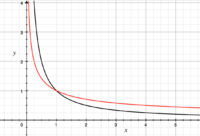hellosoupy
New member
- Joined
- Mar 28, 2021
- Messages
- 13
Hi!
This is a general question that came up for me while studying microeconomics: Is there any way to find the area under the curve for the function 1/x from say, 0 to 1, since the integral of 1/x is ln x + C (the natural log of the absolute value of x that is)? I evaluated the definite integral from various tiny numbers to 1, and the tinier you go, the higher and higher the number gets.
Thanks in advance!
Jaux
This is a general question that came up for me while studying microeconomics: Is there any way to find the area under the curve for the function 1/x from say, 0 to 1, since the integral of 1/x is ln x + C (the natural log of the absolute value of x that is)? I evaluated the definite integral from various tiny numbers to 1, and the tinier you go, the higher and higher the number gets.
Thanks in advance!
Jaux

